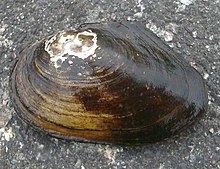Loading AI tools
Subclass of bivalves From Wikipedia, the free encyclopedia
Palaeoheterodonta is a subterclass of bivalve molluscs.[1][2] It contains the extant orders Unionida (freshwater mussels) and Trigoniida. They are distinguished by having the two halves of the shell be of equal size and shape, but by having the hinge teeth be in a single row, rather than separated into two groups, as they are in the clams and cockles.[3]
| Palaeoheterodonta Temporal range: | |
|---|---|
 | |
| Anodonta anatina | |
| Scientific classification | |
| Domain: | Eukaryota |
| Kingdom: | Animalia |
| Phylum: | Mollusca |
| Class: | Bivalvia |
| Subclass: | Autobranchia |
| Infraclass: | Heteroconchia |
| Subterclass: | Palaeoheterodonta Newell, 1965 |
| Orders | |
In 2010 a new proposed classification system for the Bivalvia was published in by Bieler, Carter & Coan revising the classification of the Bivalvia, including the subclass Paleoheterodonta.[4] Superfamilies and families as listed by Bieler et al. Use of † indicate families and superfamilies that are extinct.
Subterclass: Palaeoheterodonta
Seamless Wikipedia browsing. On steroids.
Every time you click a link to Wikipedia, Wiktionary or Wikiquote in your browser's search results, it will show the modern Wikiwand interface.
Wikiwand extension is a five stars, simple, with minimum permission required to keep your browsing private, safe and transparent.